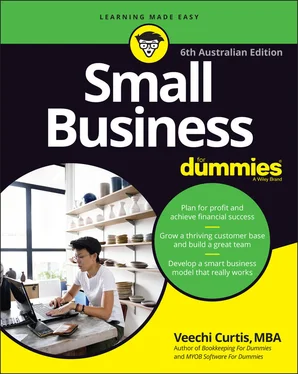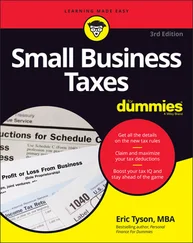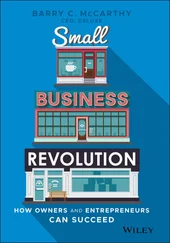1 ...8 9 10 12 13 14 ...19 In contrast, lawn mowing has few potential strategic advantages but probably the lowest risk of all. (The cost for Leila to set up her business could be as low as placing an ad on Facebook Marketplace.) The reason that strategic advantages are hard to find for Leila’s business is that a lawn is only ever a lawn, and Leila is limited in what she can offer that others can’t.
However, I still include ‘maybe’ against three possible strategic advantages for Leila’s lawn mowing business:
Added value: Maybe Leila has some specialist horticultural knowledge that could differentiate her from her competitors.
Location: Maybe Leila would be providing the only service in her suburb, or maybe she lives in a very exclusive suburb with lots of high-income earners.
Lower costs: Maybe Leila’s teenage son works for her at low hourly rates, enabling Leila to afford very competitive prices.
 If your business is very similar to many others, you may find it’s tricky to identify strategic advantages and to stand out from your competitors. The upside of a business that’s very similar to many others is that the risks are usually lower; the downside of a low-risk business is that it’s always going to be tricky to charge premium rates or make above-average profits.
If your business is very similar to many others, you may find it’s tricky to identify strategic advantages and to stand out from your competitors. The upside of a business that’s very similar to many others is that the risks are usually lower; the downside of a low-risk business is that it’s always going to be tricky to charge premium rates or make above-average profits.
Figuring Out Who Your Competitors Really Are
I like to organise competitors into three broad groups, and I suggest you try to do so too:
Head-to-head competitors provide exactly the same service or exactly the same product as you do.
‘Sometimes’ competitors provide a slightly different service or product, or are in a different location.
Left-field competitors don’t normally compete with you but, if circumstances were to change, could possibly do so.
 When you’re thinking about the competition for your proposed business, don’t be too literal — think about where both your business and its industry are headed. For example, a watchmaker repairing and selling watches 30 years ago would have probably thought that the main competition was other watchmakers. The idea that the mobile phone could almost completely annihilate this industry would seem a long shot.
When you’re thinking about the competition for your proposed business, don’t be too literal — think about where both your business and its industry are headed. For example, a watchmaker repairing and selling watches 30 years ago would have probably thought that the main competition was other watchmakers. The idea that the mobile phone could almost completely annihilate this industry would seem a long shot.
Also, don’t be hesitant to compare your business against big-time competitors such as supermarket chains or large franchises. While you may find it hard to imagine how your fledgling business could ever compete, the mass-market nature of these competitors often leaves niches that are underserviced, providing opportunities for smaller players.
Understanding why you need to do this
Here are five reasons I recommend you spend time analysing your competitors:
You can get fresh inspiration: Your competition can be a source of inspiration, showing you where to gain a possible edge. Pricing specials, weekend packages, discount offers, creative advertising and clever sales techniques are just some of the things you may decide to copy. After all, imitation is the greatest form of flattery (although your competitors may not see it that way!).
You can avoid terrible mistakes: Competitor analysis may provide the reality check that prevents you from taking unnecessary risks and losing your savings. For example, in my local town a whole strip of cafes come and go with every change in season. If I were thinking about starting a cafe, a competitor analysis may quickly reveal that the rents in this strip are hideously high, the landlords are difficult, and nobody is making enough profits to survive, let alone thrive.
You can capitalise on others’ weaknesses: Interacting with competitors can also point to potential opportunities. For many people, the seed of a winning business idea is sown by not being able to receive good enough service or quite the right product. So they think, I can do better than that , and a new business idea or marketing strategy is born.
You can set your prices just right: If you’re going to compete head-on with another business, you want to be right across the services that business provides, and the prices it charges. Unless a massive undersupply exists, charging $20 more per hour is probably pointless if you’re providing an identical service to a close competitor.
You can identify your point of difference: Unless you know exactly what your competitors provide, you won’t know how to sell your differences.
One of the purposes of identifying competitors is so you can develop a competitive strategy to deal with each one. However, when you create a list of head-to-head competitors, this can sometimes be a long list. For example, if you’re starting up a business as an electrician, you may find 50 other electricians are working in your local area. You don’t want to have to come up with 50 different competitive strategies, so your best tactic is to try to group these competitors in some way.
Try this process:
1 List your competitors in a small number of groups based on similarities.For example, the electrician may split their list of 50 other electricians according to size of the business, focus of the business (maybe some focus more on repairs, others on hot water, others on new buildings), or by locality or suburb.
2 Think about how you’ve organised these groups. Will a customer looking for your kind of business use these same criteria?For example, if a customer is searching online for an electrician, are they going to search by suburb, by specialty, or by services provided (such as 24-hour call outs)?
3 Have a think about where you belong in the scheme of things.For example, the electrician may decide they want to focus on solar systems but within a 50-kilometre radius only.
4 Think to the future. Do you want to be in this same group in five years’ time?For example, maybe the electrician has a vision to offer not just solar installations, but home-energy consultations also.
 By organising your competitors into groups, you can build a clearer idea about how to develop different competitive strategies, depending on what kind of competitor you’re dealing with.
By organising your competitors into groups, you can build a clearer idea about how to develop different competitive strategies, depending on what kind of competitor you’re dealing with.
Profiling your competitors
When investigating your competitors, don’t limit yourself to visiting your competitor’s website but, instead, try to dig a little deeper. The time has come for you to don your dark sunglasses, felt hat and fake moustache. Talk to your competitors’ suppliers or distributors, or quiz customers who have defected to your side of the fence. You may even have to go undercover and pose as a customer (or ask a family member to do so) — I know that such clandestine activity can feel a bit weird, but the results are usually worth it.
Table 2-2shows a detailed competitive analysis where the owner of a copywriting business does a comparison with three other copywriting businesses also offering services online, rating competitors according to what they do better (or worse).
TABLE 2-2Rating Head-to-Head Competitors
| Does this competitor … |
ABC |
CopytoGo |
WriteNow |
| Have cheaper pricing than me? |
Yes |
No |
No |
| Offer a faster turnaround time? |
No |
No |
Yes |
| Offer specific services that I don’t? |
No |
Yes |
No |
| Offer onsite services, not just online? |
No |
No |
No |
| Offer a larger variety of pricing packages? |
No |
No |
Yes |
| Have more expertise/a higher level of skill? |
No |
No |
No |
| Service different niches? |
No |
No |
No |
| Have more testimonials than me? |
Yes |
No |
No |
| Have a more active social media presence? |
No |
No |
Yes |
| Have a stronger online marketing strategy? |
No |
No |
Yes |
| Have more capital and power to expand? |
No |
No |
Yes |
Thinking about future competitors
Читать дальше

 If your business is very similar to many others, you may find it’s tricky to identify strategic advantages and to stand out from your competitors. The upside of a business that’s very similar to many others is that the risks are usually lower; the downside of a low-risk business is that it’s always going to be tricky to charge premium rates or make above-average profits.
If your business is very similar to many others, you may find it’s tricky to identify strategic advantages and to stand out from your competitors. The upside of a business that’s very similar to many others is that the risks are usually lower; the downside of a low-risk business is that it’s always going to be tricky to charge premium rates or make above-average profits. When you’re thinking about the competition for your proposed business, don’t be too literal — think about where both your business and its industry are headed. For example, a watchmaker repairing and selling watches 30 years ago would have probably thought that the main competition was other watchmakers. The idea that the mobile phone could almost completely annihilate this industry would seem a long shot.
When you’re thinking about the competition for your proposed business, don’t be too literal — think about where both your business and its industry are headed. For example, a watchmaker repairing and selling watches 30 years ago would have probably thought that the main competition was other watchmakers. The idea that the mobile phone could almost completely annihilate this industry would seem a long shot. By organising your competitors into groups, you can build a clearer idea about how to develop different competitive strategies, depending on what kind of competitor you’re dealing with.
By organising your competitors into groups, you can build a clearer idea about how to develop different competitive strategies, depending on what kind of competitor you’re dealing with.










